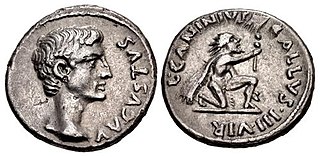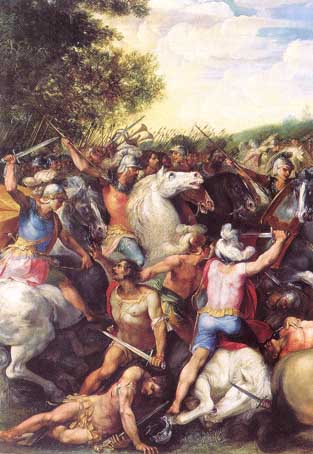Origin
The Hostilii came originally from Medullia, an ancient city in Latium, and are thought to have settled at Rome in the time of Romulus. Although the Hostilii of the Republic had no specific tradition about Medullia, coins minted by one of the later Hostilii bear the heads of Pallor and Pavor, the gods of fear and panic, in an allusion to Tullus Hostilius, who vowed temples to Pallor and Pavor during his war with Veii and Fidenae. If the later Hostilii were descended from the Hostilii of the regal period, then they were of Medullian origin. [2]
The nomen Hostilius is a patronymic surname, based on the praenomen Hostus , which was borne by the ancestors of the gens. The same praenomen gave rise to another gens, with the nomen Hostius. The earliest known member of the Hostilii was Hostus Hostilius, a Roman champion in the earliest days of the city. However, if he also bore the nomen Hostilius, then that name must have originated at an earlier time. The meaning of the praenomen remains obscure; but it could possibly have originated as a variation of Faustus, another ancient name meaning fortunate; in Etruscan we find two possible cognates, the feminine praenomina Fasti and Hasti, of which the latter is a variation of the former. [3] [4]

The gens Furia, originally written Fusia, and sometimes found as Fouria on coins, was one of the most ancient and noble patrician houses at Rome. Its members held the highest offices of the state throughout the period of the Roman Republic. The first of the Furii to attain the consulship was Sextus Furius Medullinus in 488 BC.
The gens Baebia was a plebeian family in ancient Rome. The first member of the gens who obtained the consulship was Gnaeus Baebius Tamphilus, in 182 BC. During the later Republic, the Baebii were frequently connected with the patrician family of the Aemilii.

The gens Mamilia was a plebeian family at ancient Rome during the period of the Republic. The gens was originally one of the most distinguished families of Tusculum, and indeed in the whole of Latium. It is first mentioned in the time of the Tarquins; and it was to a member of this family, Octavius Mamilius, that Lucius Tarquinius Superbus, the seventh and last King of Rome, betrothed his daughter. The gens obtained Roman citizenship in the 5th century BC, and some of its members must subsequently have settled at Rome, where Lucius Mamilius Vitulus became the first of the family to hold the consulship in 265 BC, the year before the First Punic War.

The gens Cloelia, originally Cluilia, and occasionally written Clouilia or Cloulia, was a patrician family at ancient Rome. The gens was prominent throughout the period of the Republic. The first of the Cloelii to hold the consulship was Quintus Cloelius Siculus, in 498 BC.
The gens Curiatia was a distinguished family at Rome, with both patrician and plebeian branches. Members of this gens are mentioned in connection with the reign of Tullus Hostilius, the third King of Rome, during the seventh century BC. The first of the Curiatii to attain any significant office was Publius Curiatius Fistus, surnamed Trigeminus, who held the consulship in 453 BC. The gens continued to exist throughout the Republic, and perhaps into imperial times, but seldom did its members achieve any prominence.
Hostus is a Latin praenomen, or personal name, which was used in pre-Roman times and during the early centuries of the Roman Republic, but become obsolete by the 1st century BC. The feminine form was probably Hosta or Hostia. The patronymic gentes Hostia and Hostilia were derived from Hostus. The name was not regularly abbreviated.
Tullus is a Latin praenomen, or personal name, which was used from the earliest times to the end of the Roman Republic. Although never particularly common, the name gave rise to the patronymic gens Tullia, and it may have been used as a cognomen by families that had formerly used the name. The feminine form is Tulla. The name is not usually abbreviated, but is sometimes found with the abbreviation Tul.

The gens Caninia was a plebeian family at ancient Rome during the later Republic. The first member of the gens who obtained any of the curule offices was Gaius Caninius Rebilus, praetor in 171 BC; but the first Caninius who was consul was his namesake, Gaius Caninius Rebilus, in 45 BC.

The gens Sestia was a family at ancient Rome. The gens was originally patrician, but in later times there were also plebeian members. The only member of the family to obtain the consulship under the Republic was Publius Sestius Capitolinus Vaticanus, in 452 BC.
The gens Sextilia was a plebeian family at ancient Rome. The first member of this gens to achieve prominence was Gaius Sextilius, consular tribune in 379 BC. None of the family obtained the consulship, but they endured throughout Roman history from the early Republic into imperial times.
The gens Verginia or Virginia was a prominent family at ancient Rome, which from an early period was divided into patrician and plebeian branches. The gens was of great antiquity, and frequently filled the highest honors of the state during the early years of the Republic. The first of the family who obtained the consulship was Opiter Verginius Tricostus in 502 BC, the seventh year of the Republic. The plebeian members of the family were also numbered amongst the early tribunes of the people.
The gens Cincia was a plebeian family at Rome. The first member of the gens to achieve prominence was Lucius Cincius Alimentus, who was elected praetor in 209 BC.
The gens Fabricia was a plebeian family of ancient Rome. Members of this gens are known from the early third century BC down to the end of the Republic, but they seldom attained positions of importance in the Roman state.

The gens Curtia was an ancient but minor noble family at Rome, with both patrician and plebeian branches. The only member of the gens invested with the consulship under the Republic was Gaius Curtius Philo, in 445 BC. A few Curtii held lesser magistracies during the Republic, and there were two consuls suffectus in imperial times. However, the gens is best remembered from a series of legends dating from the traditional founding of the city to the early Republic.
The gens Decimia was a plebeian family at ancient Rome. Members of this gens are first mentioned towards the end of the third century BC.
The gens Digitia was a plebeian or family at Rome. Members of this gens are first mentioned during the Second Punic War.
The gens Duronia was a plebeian family at Rome. Although relatively obscure, the family was of sufficient importance to hold a seat in the Roman Senate. Its members are mentioned during the first and second centuries BC.

The gens Fonteia was a plebeian family at ancient Rome. Members of this gens are first mentioned toward the end of the third century BC; Titus Fonteius was a legate of Publius Cornelius Scipio during the Second Punic War. The first of the Fonteii to obtain the consulship was Gaius Fonteius Capito, consul suffectus in 33 BC.
The gens Manilia was a plebeian family at ancient Rome. Members of this gens are frequently confused with the Manlii, Mallii, and Mamilii. Several of the Manilii were distinguished in the service of the Republic, with Manius Manilius obtaining the consulship in 149 BC; but the family itself remained small and relatively unimportant.
Gnaeus Octavius was a Roman politician and general who served as consul in 165 BC and was the builder of the Porticus Octavia.







